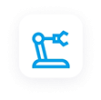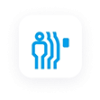Along with the development in technology, innovation in the field of robotics has also come a long way. Sensors are an integral part of robots which helps them perceive the physical and geometric properties of the world around them and react upon spontaneous input. Sensors define the linearity of response and its timeliness, without which it is impossible for a robot to perform perceptively. As robots become more advanced, more adapted sensor technology is bound to come, and with it, new applications where robots can be put to use.
This list features six unconventional ways robotics is productively used today.
1. Robobear
Robobear is a unique approach to caregiving. This bear-shaped robot is capable of lifting patients and carrying them to bed or helping those who have trouble getting up. Robobear includes actuator units with a considerably low gear ratio which allows its joints to move easily and with precision. This robot includes three different sensors, including torque sensors and smart tactile sensors made of rubber. These sensors allow gentle movements, ensuring that the robot can safely perform heavy tasks such as lifting patients. Robobear’s legs extend while lifting patients, and their retractability makes it easier for the robot to move in tight spaces such as doorways.
2. Mechanical Bird
SNAG (Stereotyped Nature-inspired Aerial Grasper) is a bird-inspired robot that impressively mimics the grasp of a peregrine falcon. SNAG has a lightweight 3D printed skeletal structure, perfected after multiple iterations. This bird-shaped robot shows potential in monitoring climate, natural ecosystems, remote sensing, or even search and rescue operations. The robot consists of two independent legs and a quadcopter attached to its frame for flight. The mechanical legs can grasp an object in mid-air or any branch while absorbing the impact force of landing. This fast-moving aerial robot uses ultrasonic sensors to perceive its surroundings and other sensors to calculate factors such as load-shifting.
3. Interactive 3D Holograms
3D Holograms are excellent for presenting complex objects with depth. However, with sensor technologies like LiDAR, it is possible to take holography to the next level and make holograms interactive. One such remarkable application was recently launched at the Dallas Holocaust Museum in Texas, USA. Using high-definition holograms of the survivors, voice recognition technology, and LiDAR sensor, visitors can now interact with holograms of Holocaust survivors, ask them questions, and receive responses through pre-recorded answers. The LiDAR sensor mounted to the wall uses a directional microphone to scan the audience and locate the visitor who wishes to ask the question. The holographic survivor replies in real-time once the visitor sits back.
4. Robot Salamander
Pleurobot walks and swims like a salamander with great precision. The 3D printed body and a well-articulated spine give this bot its recognizable salamander appearance. This robot uses 27 motors and 11 spine segments which is far less than the amphibian’s 40 vertebrates, to create a similar function. Pleurobot was designed after observing high-speed cineradiographic recordings of the animal’s movements, analyzed at 500 frames per second. The robot requires cameras and depth sensors to move in complex environments. Pleurobot can crawl to places that are otherwise hard to reach by humans. Moreover, the study put into its creation can help understand the functioning of human vertebrates as well.
5. Super Strength Exoskeleton
Sarcos robotics’s full-body exoskeleton enhances human performance and prevents injury while performing heavy-lifting operations. The robotic frame enables the operator to lift up to 200 pounds for eight hours straight without feeling strained. Humans can wear or remove this exoskeleton in as little as 30 seconds while none of its weight falls on the bearer. Sensor-based automation allows this machine to keep up with human movements and perform expeditiously. Although this robotic apparel is designed for industrial use, it can help perform hefty tasks in almost every domain.
6. Self Driving LiDAR Sensor Cars
Such autonomous cars can substantially increase roadway capacity and reduce traffic congestion. An automated driving system with LiDAR sensors aims to prevent traffic accidents and save time with improved sensor navigation. These vehicles can sense the surroundings, navigate, and fulfill human transportation requirements without any manual intervention. LiDAR sensors use light in the form of pulsated lasers to help these vehicles track obstacles and quantify their distance.
Side with the Industry Leaders in Sensor Tech
With over 70+ years of experience, Hokoyu is a pioneer of automation and sensor technology, supporting OEMs, end-users, integrators, R&D firms, and resellers in manufacturing, material handling, autonomous robotics, and metals industry applications across North America. We offer a full range of industrial sensor products suitable for factory automation, logistics automation, and process automation industries.

 Factory Automation
Factory Automation Logistics Automation
Logistics Automation Process Automation
Process Automation Crane Collision Avoidance
Crane Collision Avoidance LiDAR/Obstacle Detection
LiDAR/Obstacle Detection Safety Laser Scanners
Safety Laser Scanners Optical Data Transmission
Optical Data Transmission Hot Metal Detectors
Hot Metal Detectors Laser Distance Sensor
Laser Distance Sensor Blog
Blog Whitepapers
Whitepapers Case Studies
Case Studies Infographics
Infographics